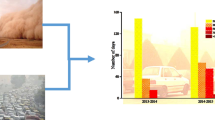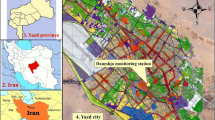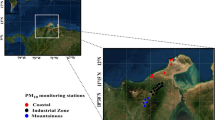Abstract
The main objective of this work is the assessment of the annual number of hospital admissions for respiratory disease (HARD) due to the exposure to inhalable particulate matter (PM10), within the greater Athens area (GAA), Greece. Towards this aim, the time series of the particulate matter with aerodynamic diameter less than 10 μm (PM10) recorded in six monitoring stations located in the GAA, for a 13-year period 2001–2013, is used. In this study AirQ2.2.3 software developed by the WHO, was used to evaluate adverse health effects by PM10 in the GAA during the examined period. The results show that, the mean annual HARD cases per 100,000 inhabitants ranged between 20 (suburban location) and 40 (city centre location). Approximately 70 % of the annual HARD cases are due to city centre residents. In all examined locations, a declining trend in the annual number of HARD cases is appeared. Moreover, a strong relation between the annual number of HARD cases and the annual number of days exceeding the European Union daily PM10 threshold value was found.
Access provided by CONRICYT-eBooks. Download conference paper PDF
Similar content being viewed by others
Keywords
These keywords were added by machine and not by the authors. This process is experimental and the keywords may be updated as the learning algorithm improves.
1 Introduction
Various epidemiological studies have shown the significant impacts of urban air pollution on human health. More concretely, several epidemiological studies have shown that the adverse health effects are related to both short and long term exposure to inhalable particulate matter (Dockery et al. 1992; Katsouyanni 2003; Paliatsos et al. 2006; Pope and Dockery 2006; Nastos et al. 2010). The GAA, like most metropolitan areas in the world, faces severe air pollution problems due to high population density and the accumulation of major economic activities in this region. The contribution of the intense sunshine to the high levels of photochemical air pollution, especially during summer months, is significant. The air pollution problems are often exacerbated by factors that favor the accumulation of air pollutants over the city, such as topography (basin surrounded by mountains), narrow and deep street canyons and adverse meteorological conditions, such as temperature inversions, low wind speed, high air temperature, extensive periods of dryness (Larissi et al. 2010a).
In this study, an effort was made to assess the annual number of hospital admissions for respiratory disease (HARD) due to the exposure to inhalable particulate matter (PM10), within the GAA, Greece.
2 Data and Methodology
The city of Athens and generally the GAA is located in an area of complex topography within the Athens basin (~450 km2) being the southernmost capital on the European mainland. Mountains bound the Athens basin with heights ranging from 400 to 1500 m at the west, north and east sides. Openings exist between these mountains at the northeast and at the west of the basin, while the sea extends southwards (Saronikos Gulf). The Athens basin has a southwest to northeast major axis and is bisected by a cluster of small hills. The prevailing winds blow from N and NE in late summer, fall and winter and from SSW and SW in spring and early summer. The NE and SW directions coincide with the major geographical axis of the basin. The ventilation of the basin is poor during the prevalence of local circulation systems, such as sea/land-breezes (Larissi et al. 2010a).
For the estimation of HARD cases mean daily concentrations of PM10 used in this research recorded by the network of the Greek Ministry of Environment and Energy (GMEE). In the current work the mean daily PM10 concentration values in six of the GMEE’s network stations are examined during the 13-year period 2001–2013. Monitoring stations are classified as centre city (CC) or suburban (S) ones, by their location, and also as traffic (T) or back-ground (BG) ones, by their categorization (Table 1).
In order to estimate the annual number of HARD cases within the GAA, the Air Quality Health Impact Assessment Tool (AirQ2.2.3) was applied. The AirQ2.2.3 model is a specialized software that enables the user to assess the potential impact of exposure to a given air pollutant on human health in a defined urban area during a certain time period. The model requires the following data (Shakour et al. 2011; Habeebullah 2013; Jeong 2013; Moustris et al. 2016):
-
I.
The coordinates of the monitoring site.
-
II.
The total exposed population.
-
III.
The number of days in which the mean daily PM10 concentration falls within categories of intervals of 10 mg m−3 (e.g., 0–9, 10–19, 20–29, etc.).
-
IV.
The annual and seasonal arithmetic mean of mean daily values.
-
V.
The annual 98th percentile of mean daily values.
-
VI.
The annual and seasonal maximum daily values.
-
VII.
The relative risk (RR).
The AirQ2.2.3 model can be used to estimate the cumulative number of cases per 100,000 persons for each concentration range, the associated relative risk, and the number of HARD cases (Shakour et al. 2011; Habeebullah 2013; Jeong 2013; Moustris et al. 2016).
3 Results
The application of AirQ2.2.3 model at the six examined locations showed that the centre of Athens (ARI) presents the highest annual number of HARD cases.
Figure 1 depicts that in the city centre location ARI the total contribution of annual HARD cases, during the examined 13-year period, is equal to 69 %. This may be attributed to the fact that city centre locations characterized by violations above the PM10’s EU limit values (Larissi et al. 2010b). The contribution of the CAA’s port (PIR) is about 13 %, then 6 % is MAR and THR and finally about 3 % is the contribution of AGP and LYK. This contribution is strongly associated with the local sources of PM10 in each examined location.
On the contrary, the contribution of each location to the annual number of HARD cases per 100,000 inhabitants is different. The results of the application of AirQ2.2.3 model concerning this magnitude, for all studied locations and for the whole examined period 2001–2013 reveal that LYK, ARI, PIR and MAR are the worst areas presenting a number of mean annual HARD cases per 100,000 inhabitants 40 ≤ HARD ≤ 35. The areas of AGP and THR presenting a number of mean annual HARD cases per 100,000 inhabitants 22 ≤ HARD ≤ 20, respectively.
In order to provide quantitative relations for the temporal variability of the annual number of HARD cases per 100,000 inhabitants and the annual means of PM10 concentrations during the examined 13-year period, scatter diagrams were constructed (Fig. 2a, b).
Figure 2a depicts that, by using the linear model, 91.2 % of the variance (R2 = 0.912) of annual values of HARD cases can be explained by the evolution of time. Moreover, for the mean annual PM10 concentrations, using the linear model, 90.1 % of the variance (R2 = 0.901) of means can be explained by the evolution of time (Fig. 2b). According to the performed analysis, during the 13-year period started in 2001, strong decreasing trend patterns appear both annual HARD cases per 100,000 inhabitants (Fig. 2a) and mean annual PM10 concentration values (Fig. 2b) all over GAA.
Figure 3 presents the spatial distribution of the mean annual HARD cases within the GAA in relation to the total population and the activities of each examined location. From this figure is depicted that the centre of Athens (ARI) is the most populous and burdened area. Secondary, the port (PIR) follows due to shipping activities. Finally, all the other locations present a similar low intensity pattern.
Finally, in order to provide a quantitative relation between the annual numbers of HARD cases and the annual numbers of days where PM10 concentration values exceed the European Council (EC) threshold of 50 μg/m3 (Directive 2008/50/EC) was investigated. Figure 4 indicates that by using the exponential fitting model, 77.7 % (R2 = 0.777) of the variance of annual HARD cases can be associated with the variations of the annual numbers of days with excesses.
4 Conclusions
The main objective of this study was the estimation of annual number of HARD cases that attributed to PM10 exposure in the greater Athens area and performed by the use of AirQ2.2.3 model. Results showed that there is a strong relationship between the HARD cases and PM10 exposure levels. Also, a decreasing trend during the examined 13-year period concerning the annual number of HARD cases and the mean annual PM10 concentration values within the GAA simultaneously was found.
References
Directive 2008/50/EC of the European Parliament and of the Council (2008) On ambient air quality and cleaner air for Europe. Off J Eur Union L152:1–43
Dockery DW, Schwartz J, Spengler JD (1992) Air pollution and daily mortality: association with particulates and acid aerosols. Environ Res 59:362–373
Habeebullah TM (2013) Health impacts of PM10 using AirQ2.2.3 model in Makkah. J Basic Appl Sci 9:259–268
Jeong SJ (2013) The impact of air pollution on human health in Suwon City. Asian J Atmos Environ 7:227–233
Katsouyanni K (2003) Ambient air pollution and health. Br Med Bull 68:143–156
Larissi IK, Antoniou A, Nastos PT, Paliatsos AG (2010a) The role of wind in the configuration of the ambient air quality in Athens, Greece. Fresen Environ Bull 19:1989–1996
Larissi IK, Koukouletsos KV, Moustris KP, Antoniou A, Paliatsos AG (2010b) PM10 concentration levels in the greater Athens area, Greece. Fresen Environ Bull 19:226–231
Moustris KP, Proias GT, Larissi JK, Nastos PT, Koukouletsos KV, Paliatsos AG (2016) Health impacts due to particulate air pollution in Volos City, Greece. J Environ Sci Heal A 51(1):15–20
Nastos PT, Paliatsos AG, Anthracopoulos MB, Roma ES, Priftis KN (2010) Outdoor particulate matter and childhood asthma admissions in Athens, Greece: a time-series study. Environ Health 9:45. doi:10.1186/1476-069X-9-45
Paliatsos AG, Priftis KN, Ziomas IC, Panagiotopoulou-Gartagani P, Nikolaou-Panagiotou A, Tapratzi-Potamianou P, Zachariadi-Xypolita A, Nicolaidou P, Saxoni-Papageorgiou P (2006) Association between ambient air pollution and childhood asthma in Athens, Greece. Fresen Environ Bull 15:614–618
Pope CA 3rd, Dockery DW (2006) Health effects of fine particulate air pollution: lines that connect. J Air Waste Manage Assoc 56:709–742
Shakour AA, El-Shahat MF, El-Taieb NM, Hassanein MA, Mohamed AMF (2011) Health impacts of particulate matter in greater Cairo, Egypt. J Am Sci 7:840–848
Author information
Authors and Affiliations
Corresponding author
Editor information
Editors and Affiliations
Rights and permissions
Copyright information
© 2017 Springer International Publishing Switzerland
About this paper
Cite this paper
Ntourou, K., Moustris, K.P., Giannouli, M., Nastos, P.T., Paliatsos, A.G. (2017). Estimation of Hospital Admissions Respiratory Disease Attributed to PM10 Exposure Using the AirQ Model Within the Greater Athens Area. In: Karacostas, T., Bais, A., Nastos, P. (eds) Perspectives on Atmospheric Sciences. Springer Atmospheric Sciences. Springer, Cham. https://doi.org/10.1007/978-3-319-35095-0_158
Download citation
DOI: https://doi.org/10.1007/978-3-319-35095-0_158
Published:
Publisher Name: Springer, Cham
Print ISBN: 978-3-319-35094-3
Online ISBN: 978-3-319-35095-0
eBook Packages: Earth and Environmental ScienceEarth and Environmental Science (R0)








